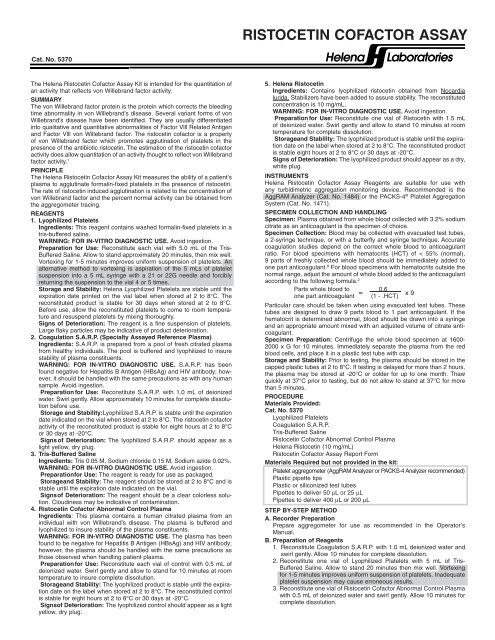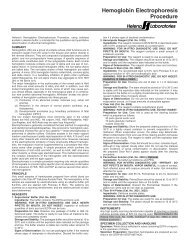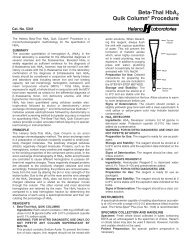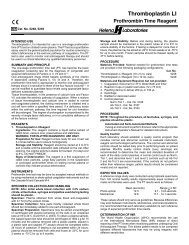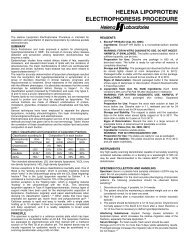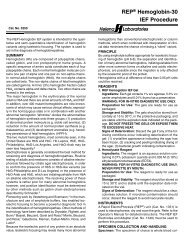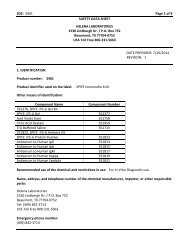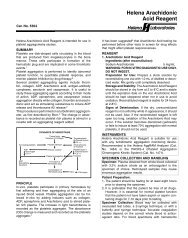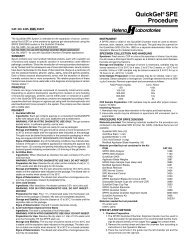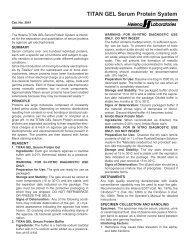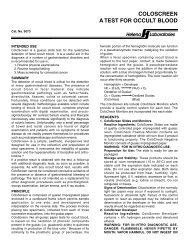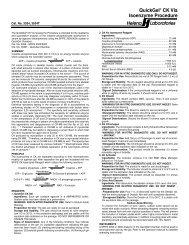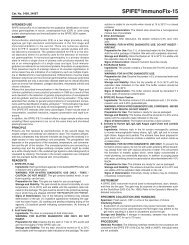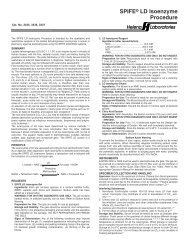RISTOCETIN COFACTOR ASSAY - Helena
RISTOCETIN COFACTOR ASSAY - Helena
RISTOCETIN COFACTOR ASSAY - Helena
- No tags were found...
Create successful ePaper yourself
Turn your PDF publications into a flip-book with our unique Google optimized e-Paper software.
<strong>RISTOCETIN</strong> <strong>COFACTOR</strong> <strong>ASSAY</strong>Cat. No. 5370 <strong>Helena</strong> LaboratoriesThe <strong>Helena</strong> Ristocetin Cofactor Assay Kit is intended for the quantitation ofan activity that reflects von Willebrand factor activity.SUMMARYThe von Willebrand factor protein is the protein which corrects the bleedingtime abnormality in von Willebrand’s disease. Several variant forms of vonWillebrand’s disease have been identified. They are usually differentiatedinto qualitative and quantitative abnormalities of Factor Vlll Related Antigenand Factor Vlll von Willebrand factor. The ristocetin cofactor is a propertyof von Willebrand factor which promotes agglutination of platelets in thepresence of the antibiotic ristocetin. The estimation of the ristocetin cofactoractivity does allow quantitation of an activity thought to reflect von Willebrandfactor activity. 1PRINCIPLEThe <strong>Helena</strong> Ristocetin Cofactor Assay Kit measures the ability of a patient’splasma to agglutinate formalin-fixed platelets in the presence of ristocetin.The rate of ristocetin induced agglutination is related to the concentration ofvon Willebrand factor and the percent normal activity can be obtained fromthe aggregometer tracing.REAGENTS1. Lyophilized PlateletsIngredients: This reagent contains washed formalin-fixed platelets in atris-buffered saline.WARNING: FOR IN-VITRO DIAGNOSTIC USE. Avoid ingestion.Preparation for Use: Reconstitute each vial with 5.0 mL of the Tris-Buffered Saline. Allow to stand approximately 20 minutes, then mix well.Vortexing for 1-5 minutes improves uniform suspension of platelets. Analternative method to vortexing is aspiration of the 5 mLs of plateletsuspension into a 5 mL syringe with a 21 or 22G needle and forciblyreturning the suspension to the vial 4 or 5 times.Storage and Stability: <strong>Helena</strong> Lyophilized Platelets are stable until theexpiration date printed on the vial label when stored at 2 to 8°C. Thereconstituted product is stable for 30 days when stored at 2 to 8°C.Before use, allow the reconstituted platelets to come to room temperatureand resuspend platelets by mixing thoroughly.Signs of Deterioration: The reagent is a fine suspension of platelets.Large flaky particles may be indicative of product deterioration.2. Coagulation S.A.R.P. (Specialty Assayed Reference Plasma)Ingredients: S.A.R.P. is prepared from a pool of fresh citrated plasmafrom healthy individuals. The pool is buffered and Iyophilized to insurestability of plasma constituents.WARNING: FOR IN-VITRO DIAGNOSTIC USE. S.A.R.P. has beenfound negative for Hepatitis B Antigen (HBsAg) and HIV antibody; however,it should be handled with the same precautions as with any humansample. Avoid ingestion.Preparation for Use: Reconstitute S.A.R.P. with 1.0 mL of deionizedwater. Swirl gently. Allow approximately 10 minutes for complete dissolutionbefore use.Storage and Stability:Lyophilized S.A.R.P. is stable until the expirationdate indicated on the vial when stored at 2 to 8°C. The ristocetin cofactoractivity of the reconstituted product is stable for eight hours at 2 to 8°Cor 30 days at -20°C.Signs of Deterioration: The Iyophilized S.A.R.P. should appear as alight yellow, dry plug.3. Tris-Buffered SalineIngredients: Tris 0.05 M, Sodium chloride 0.15 M, Sodium azide 0.02%.WARNING: FOR IN-VITRO DIAGNOSTIC USE. Avoid ingestion.Preparation for Use: The reagent is ready for use as packaged.Storage and Stability: The reagent should be stored at 2 to 8°C and isstable until the expiration date indicated on the vial.Signs of Deterioration: The reagent should be a clear colorless solution.Cloudiness may be indicative of contamination.4. Ristocetin Cofactor Abnormal Control PlasmaIngredients: This plasma contains a human citrated plasma from anindividual with von Willebrand’s disease. The plasma is buffered andIyophilized to insure stability of the plasma constituents.WARNING: FOR IN-VITRO DIAGNOSTIC USE. The plasma has beenfound to be negative for Hepatitis B Antigen (HBsAg) and HIV antibody;however, the plasma should be handled with the same precautions asthose observed when handling patient plasma.Preparation for Use: Reconstitute each vial of control with 0.5 mL ofdeionized water. Swirl gently and allow to stand for 10 minutes at roomtemperature to insure complete dissolution.Storage and Stability: The lyophilized product is stable until the expirationdate on the label when stored at 2 to 8°C. The reconstituted controlis stable for eight hours at 2 to 8°C or 30 days at -20°C.Signs of Deterioration: The Iyophilized control should appear as a lightyellow, dry plug.5. <strong>Helena</strong> RistocetinIngredients: Contains Iyophilized ristocetin obtained from Nocardialurida. Stabilizers have been added to assure stability. The reconstitutedconcentration is 10 mg/mL.WARNING: FOR IN-VITRO DIAGNOSTIC USE. Avoid ingestion.Preparation for Use: Reconstitute one vial of Ristocetin with 1.5 mLof deionized water. Swirl gently and allow to stand 10 minutes at roomtemperature for complete dissolution.Storage and Stability: The lyophilized product is stable until the expirationdate on the label when stored at 2 to 8°C. The reconstituted productis stable eight hours at 2 to 8°C or 30 days at -20°C.Signs of Deterioration: The Iyophilized product should appear as a dry,white plug.INSTRUMENTS<strong>Helena</strong> Ristocetin Cofactor Assay Reagents are suitable for use withany turbidimetric aggregation monitoring device. Recommended is theAggRAM Analyzer (Cat. No. 1484) or the PACKS-4 ® Platelet AggregationSystem (Cat. No. 1471).SPECIMEN COLLECTION AND HANDLINGSpecimen: Plasma obtained from whole blood collected with 3.2% sodiumcitrate as an anticoagulant is the specimen of choice.Specimen Collection: Blood may be collected with evacuated test tubes,a 2-syringe technique, or with a butterfly and syringe technique. Accuratecoagulation studies depend on the correct whole blood to anticoagulantratio. For blood specimens with hematocrits (HCT) of < 55% (normal),9 parts of freshly collected whole blood should be immediately added toone part anticoagulant. 8 For blood specimens with hematocrits outside thenormal range, adjust the amount of whole blood added to the anticoagulantaccording to the following formula. 2Parts whole blood to 0.6=one part anticoagulant (1 - .HCT)x 9Particular care should be taken when using evacuated test tubes. Thesetubes are designed to draw 9 parts blood to 1 part anticoagulant. If thehematocrit is determined abnormal, blood should be drawn into a syringeand an appropriate amount mixed with an adjusted volume of citrate anticoagulant.Specimen Preparation: Centrifuge the whole blood specimen at 1600-2000 x G for 10 minutes. Immediately separate the plasma from the redblood cells, and place it in a plastic test tube with cap.Storage and Stability: Prior to testing, the plasma should be stored in thecapped plastic tubes at 2 to 8°C. If testing is delayed for more than 2 hours,the plasma may be stored at -20°C or colder for up to one month. Thawquickly at 37°C prior to testing, but do not allow to stand at 37°C for morethan 5 minutes.PROCEDUREMaterials Provided:Cat. No. 5370Lyophilized PlateletsCoagulation S.A.R.P.Tris-Buffered SalineRistocetin Cofactor Abnormal Control Plasma<strong>Helena</strong> Ristocetin (10 mg/mL)Ristocetin Cofactor Assay Report FormMaterials Required but not provided in the kit:Platelet aggregometer (AggRAM Analyzer or PACKS-4 Analyzer recommended)Plastic pipette tipsPlastic or siliconized test tubesPipettes to deliver 50 µL or 25 µLPipettes to deliver 400 µL or 200 µLSTEP BY-STEP METHODA. Recorder PreparationPrepare aggregometer for use as recommended in the Operator’sManual.B. Preparation of Reagents1. Reconstitute Coagulation S.A.R.P. with 1.0 mL deionized water andswirl gently. Allow 10 minutes for complete dissolution.2. Reconstitute one vial of Lyophilized Platelets with 5 mL of Tris-Buffered Saline. Allow to stand 20 minutes then mix well. Vortexingfor 1-5 minutes improves uniform suspension of platelets. Inadequateplatelet suspension may cause erroneous results.3. Reconstitute one vial of Ristocetin Cofactor Abnormal Control Plasmawith 0.5 mL of deionized water and swirl gently. Allow 10 minutes forcomplete dissolution.
4. Reconstitute one vial of <strong>Helena</strong> Ristocetin with 1.5 mL of deionized waterto give a concentration of 10 mg/mL. (Final concentration 1 mg/mL inassay.) Swirl gently. Allow 10 minutes for complete dissolution.C. Standard Curve Preparation1. Prepare the following dilutions of Coagulation S.A.R.P. with Tris-Buffered Saline.Actual %Tube Dilution Ratio mL S.A.R.P. mL Buffer Activity1 1:2 0.1 0.1 502 1:4 0.1 0.3 253 1:8 0.1 0.7 12.5D. Preparation of Test and Control Plasma1. Prepare test and control dilutions with Tris Buffered Saline. Dilutionsshould be tested within 30 minutes.Control or Actual %Tube Dilution Ratio Test Plasma mL Buffer Activity4 1:2 0.1 0.1 505 1:4 0.1 0.3 25E. Performance of Assay NOTE: The AggRAM and the PACKS-4 can be run with the recommended(standard) volumes or with one-half (micro) volumes. Standard volumetests are done at 1000 rpm and micro volume tests are done at 600 rpm.Patient results should be compared to normal ranges run under the sameconditions.The following steps are for standard volume; for micro volume use onehalf of the standard volumes.1. Pipette 250 µL of <strong>Helena</strong>’s Iyophilized platelet suspension and 250 µLof Tris-Buffered Saline into an aggregometer cuvette with a stir bar. Set100% activity using the Aggregation Blank.2. Place a stir bar into a cuvette for each sample to be tested. Add 400µL of platelet suspension to each cuvette.3. Place the cuvette into the cuvette well. Add 50 µL of ristocetin to thecuvette. This will automatically activate a 1-3 minute incubation period.4. At the computer prompt, add 50 µL of each reference, patient or controlplasma dilutions.5. The aggregometer will record the aggregation for 5 minutes. It willautomatically calculate the slope and produce a Standard Curve;or patient or control percent activity can be calculated from a storedStandard Curve. Printouts of the curve, control and patient data areavailable.Quality Control: Quantitation of ristocetin cofactor should be monitoredusing the abnormal control, provided in the kit, and a normal control such asS.A.C.-1 (Cat. No. 5301). These controls should be used with each run andcan verify all phases of the procedure. Refer to the package insert providedwith the S.A.C.-1 for detailed information and assay values.RESULTSA. Preparation of Manual Standard Curve1. Use the report form provided and the slope values obtained from theaggregometer, to plot the actual percent activity of the CoagulationS.A.R.P. plasma dilutions (50%, 25% and 12.5%) on the horizontalaxis against the corresponding slope values on the vertical axis.2. Draw a line of best fit through these points.B. Determination of Test and Control Plasma Activity1. Plot the slope value of the test plasma and control plasma dilutions onthe vertical axis of the standard curve.2. Read the corresponding percent ristocetin cofactor activity on thehorizontal axis and multiply results by the dilution factor and the assayvalue of the reference plasma.Example:49% (% ristocetin cofactor activity from graph) x 2 (dilution factor) x1.0 (assay value) = 98% (Ristocetin Cofactor Activity).3. For activities greater than the highest point on the curve, dilute theplasma specimen appropriately in order to obtain slope values in thelinear portion of the standard curve. Multiply the test results by thereciprocal of the plasma dilution.4. For activities less than the lowest point on the curve, repeat the assayon undiluted test plasma and read the results directly off the standardcurve.REFERENCE RANGEA random sampling of 22 normal plasma specimens was tested for ristocetincofactor activity. An established range of 58-166% (0.58-1.66 units/mL) wasobtained. Fifty (50) normal plasma specimens were tested with the AggRAMand a normal range of 56 -187% (0.56 - 1.87 units / mL) was obtained. Itis recommended that each laboratory determine a reference range for itsparticular population and instrument/reagent system. Low values are anindication of von Willebrand’s disease.LIMITATIONSThe ristocetin cofactor activity fails to reflect accurately von Willebrand’sdisease in several situations such as pregnancy 3 , infusion of commercialFactor Vlll concentrates 4, 5 or administration of 1-deamino (8-d-arginine)-vasopression (DDAVP). 6 In such instances, VlllR:RCo may be corrected,yet the bleeding time remains prolonged. In addition, VlllR:RCo levels maybe normal in Type ll B von Willebrand’s disease even though the bleedingtime is prolonged. 7PERFORMANCE CHARACTERISTICSComparison Studies: Correlation studues were done using the <strong>Helena</strong>Ristocetin Cofactor Assay Method on the AggRAM and the PACKS-4. Fortysamples were tested by both methods resulting in a linear regression equationof Y = 0.97X + 1.3 (where Y is the AggRAM and X is the PACKS-4) anda correlation coefficient of 0.974.BIBLIOGRAPHY1. Zimmerman, T.S., Ruggeri, Z.M., von Willebrand’s Disease, Spaett (Ed):Progress in Thrombosis and Hemostasis, 6:203-236,1982.2. Triplett, D.A., Ed., Standardization of Coagulation Assays: An Overview,College of Am Path, Skokie, lll, pg. 4,1982.3. Ratnoff, O.D., Bennett, B., Clues to Pathogeneis of Bleeding in vonWillebrand’s Disease, N Eng J Med, 289:1182-1183,1973.4. Blatt, P.M., Brinkhous, K.M.M., Culp, H.R., et al., Antihemophilic FactorConcentrate Therapy in von Willebrand’s Disease, J Am Med Assn,236:2770-2772,1976.5. Green, D., Potter, E.V., Failure of AHF Concentrate to Control Bleedingin von Willebrand’s Disease, Am J Med, 60:357-360,1976.6. Mannucci, P.M., Pareti, F.l., Holmberg, L., et al., Studies on theProlonged Bleeding Time in von Willebrand’s Disease, J Lab Clin Med,88:662 671,1976.7. Ruggeri, Z.M., Pareti, F.l., Mannucci, P.M., et al., Heightened InteractionBetween Platelets and Factor Vlll/von Willebrand Factor in a New Subtypeof von Willebrand’s Disease, N Eng J Med, 302:1047-1051,1980.8. NCCLS, Collection, Transport, and Processing of Blood Specimens forCoagulation Testing and Performance of Coagulation Assays, 2nd ed.- H21-A2, 1991.Ristocetin Cofactor Assay KitCat. No. 5370Lyophilized Platelets (4 x 5.0 mL)Coagulation S.A.R.P. (2 x 1.0 mL)Tris-Buffered Saline (1 x 35 mL)Ristocetin Cofactor Abnormal Control Plasma (2 x 0.5 mL)<strong>Helena</strong> Ristocetin 10 mg/mL (2 x 1.5 mL)Ristocetin Cofactor Assay Report FormsComponents offered individuallyCat. No.Lyophilized Platelets (5 x 5.0 mL) 5371Coagulation S.A.R.P. (10 x 1.0 mL) 5185S.A.C.-1 (Specialty Assayed Control) (10 x 1 mL) 5301Tris-Buffered Saline (1 x 250 mL) 5365<strong>Helena</strong> Ristocetin 10 mg/mL (5 x 1.5 mL) 5372Ristocetin Cofactor Abnormal Control Plasma (5 x 0.5 mL) 5373Other Supplies and Equipment‐The following items, needed for the performance of the <strong>Helena</strong>Ristocetin Cofactor Assay Kit must be ordered individually.Cat. No.AggRAM Analyzer 1484AggRAM Stir Bars 1489PACKS-4 Platelet Aggregation System 1471AggRAM/PACKS-4 Cuvettes (200) 1473PACKS-4 Stir Bars (30) 1474For Sales, Technical and Order Information, and Service Assistance, call800-231-5663 toll free.<strong>Helena</strong> Laboratories warrants its products to meet our published specifications and to be freefrom defects in materials and workmanship. <strong>Helena</strong>’s liability under this contract or otherwiseshall be limited to replacement or refund of any amount not to exceed the purchase priceattributable to the goods as to which such claim is made. These alternatives shall be buyer’sexclusive remedies.In no case will <strong>Helena</strong> Laboratories be liable for consequential damages even if <strong>Helena</strong> hasbeen advised as to the possibility of such damages.The foregoing warranties are in lieu of all warranties expressed or implied including, but notlimited to, the implied warranties of merchantability and fitness for a particular purpose.Shaded areas indicate that text has been modified, added or deleted.<strong>Helena</strong> Laboratories Pro. 64Beaumont, Texas8/04(5)


